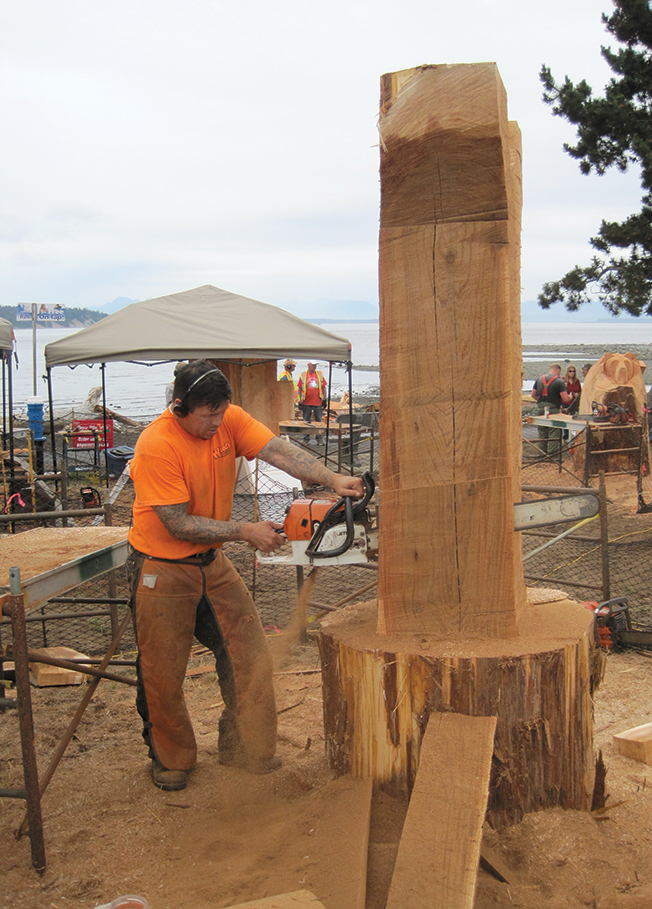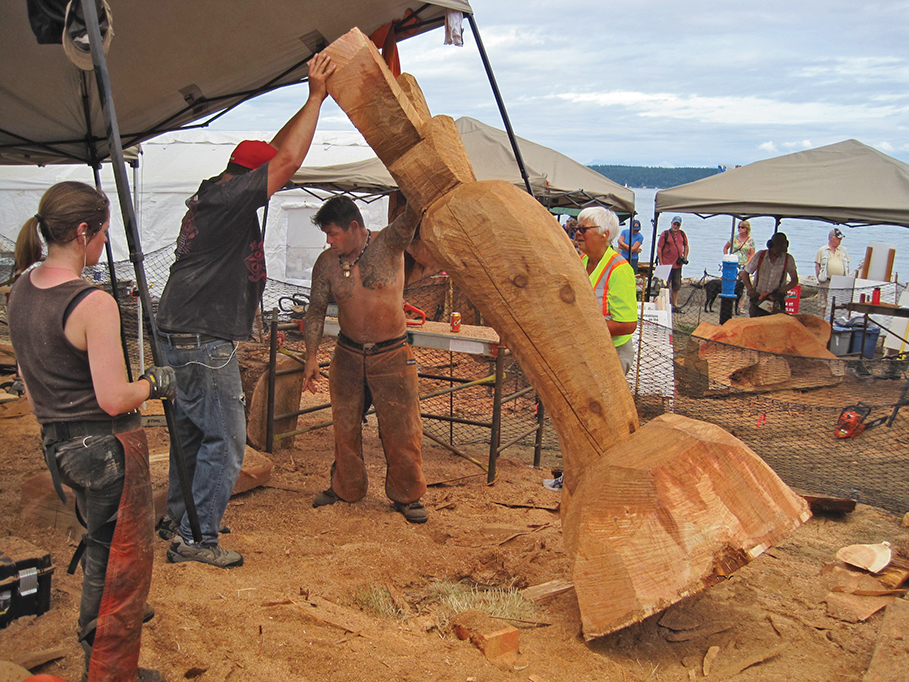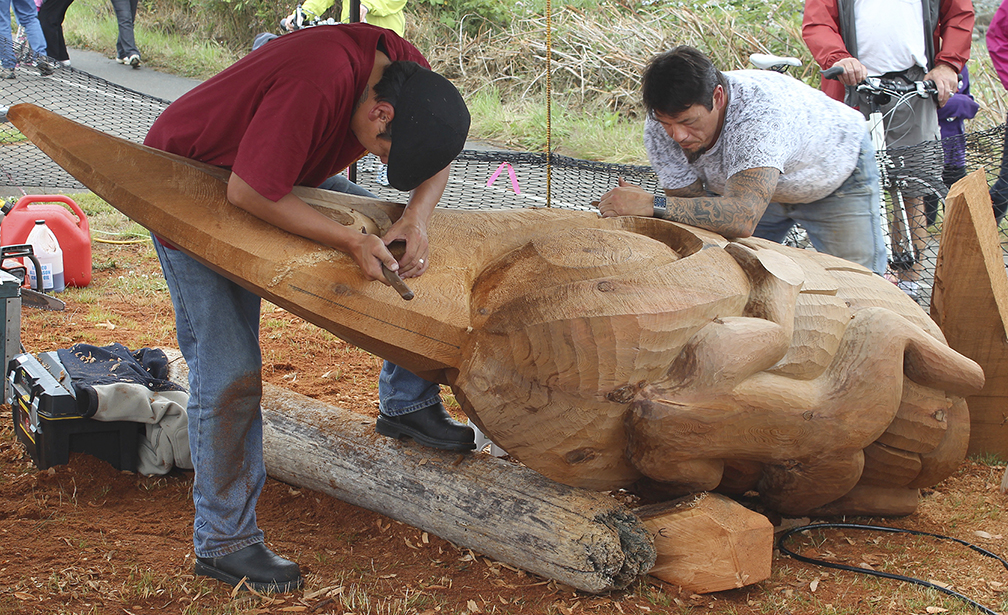Junior Henderson is doing his part to keep his culture alive, because he knows how close it was to being lost forever.
The eldest son of the eldest son of Master Carver Sam Henderson – a name known around the world for his cultural art done right here in and around Campbell River – Junior’s life has been surrounded by his people’s art and culture since birth, and while it was never “forced” on him, he says, it was natural that he would absorb it organically and make it an important aspect of his life.
 His father, Henderson says, “went away when he was young to go learn his culture and learn who he was and where he was really from. He knew he wasn’t just from here in Campbell River, and he wanted to learn the language, as well.”
His father, Henderson says, “went away when he was young to go learn his culture and learn who he was and where he was really from. He knew he wasn’t just from here in Campbell River, and he wanted to learn the language, as well.”
And so as Henderson watched his father make button blankets, help with potlatches, and engage with his culture in any and every way he could, it just kind of rubbed off on him.
“I was brought up in that life. I grew up seeing that culture, being surrounded by it, having it just be part of life. I was dragged, I guess you could say, to all these things, and I didn’t really have an understanding of it when I was younger, but as I got older I started to understand.”
As he was about to graduate from high school, like many others, he was trying to figure out how he’d make a living, “and my uncle was doing pretty well as a carver, and I knew my grandfather was a renowned artist worldwide, and I kinda wanted to just be like him.”
So when, after a couple of years working in forestry, his uncle took him under his wing in a protege/mentor kind of role. That was 20 or so years ago, now, and he’s never looked back.
“I guess at this point, I’ve devoted more than half my life to be like Sam Henderson – who I hardly knew,” he says, looking down at the large log outside the carver’s shed out on the spit that he’s skinning and preparing
to begin work on, giving it a loving pat with the palm of his hand.
That log will become the new totem pole to replace the Kwakiutl Bear Pole his grandfather carved as part of theRoute of Totems Centennial project in 1966, and had stood overlooking the strait at the Museum at Campbell River for years.
Over the years since its creation, however, issues of ownership and responsibility for its upkeep and maintenance became clouded, so it, unfortunately, deteriorated beyond repair despite attempts to restore it, and Henderson was commissioned to replace it.
While he gets excited about every project he works on, “this one’s a little extra exciting,” he admits.
 “My grandfather was fortunate to be a part of that group that revived the culture from the era when you weren’t allowed to celebrate it,” he says, “and now here I am replacing a part of that legacy that he brought back into people’s lives, in a way.”
“My grandfather was fortunate to be a part of that group that revived the culture from the era when you weren’t allowed to celebrate it,” he says, “and now here I am replacing a part of that legacy that he brought back into people’s lives, in a way.”
That culture that has been brought back into people’s lives is just the way Henderson lives. After he learned to carve, under his uncle’s tutelage, he wanted more.
“Carving, singing, dancing, I got involved in all of it,” he says. He wanted to, as he puts it, be “a cultural person.”
“Culture is a way of life,” he says. “It’s not something you walk into and out of. It’s something you’re a part of. I try my best to be a role model – that person that somebody can look up to.”
But it’s not easy to live that way, he says, but, as he says, “you have to work at it, like anything else in life that’s worth doing, I guess. But I’ve devoted my life to it.”
But there was a time, Henderson says, “not too long ago,” when he felt like giving up on the carving aspect of his life.
“The market was really bad, and I was, like, oh, man, I gotta get a real job,” he says with a laugh. But not long after that thought started creeping into his mind – consuming him, really – he was up in Alert Bay for a potlatch, and something changed his mind.
“One of the nights I was there, a pretty respected carver who I look up to gave me this talk at, like, three in the morning, about the gift I have and the talents that I carry, and it was just amazing. He couldn’t have known what I was thinking, and here he was, giving me this talk about how important it is that I’m doing what I’m doing and keeping out people strong and proud.”
“I believe in a lot of different things that are spiritual,” Henderson says, “but that was just something truly magical.”
So he’s still at it.
And he’ll be back down at the Transformations on the Shore competition this month in Willow point, as well.
“I’ve been doing it 15 years straight now, I think,” he says.
He watched the first few, he says, but it took him a few years of watching to build up the confidence to sign up. Once he did, however, he was hooked. He’s won basically every category on offer at the competition, he says, but that’s not what’s important about participating.
“I’ve gained a lot of skills from going in that contest,” he says, “and it’s also another opportunity for me to give back using my skills and my culture. And he enjoys the challenge of turning around a carving in a short time.
 “I’m used to spending a month on a piece, right? So then to go whip one out in a couple of days … well, you’ve gotta go in with a good plan, and your time is precious in those kinds of competitions. Every minute is important, so it’s a totally different kind of experience.”
“I’m used to spending a month on a piece, right? So then to go whip one out in a couple of days … well, you’ve gotta go in with a good plan, and your time is precious in those kinds of competitions. Every minute is important, so it’s a totally different kind of experience.”
These events are also about the camaraderie. Many of the carvers at a competition like Transformations on the Shore come every year – or most years – and Henderson says he enjoys meeting up with them whenever they come back.
“Some of those guys, man, they just travel around carving, selling enough work to make it up the road to the next competition, and they’ve got some great stories to share. They’re fun guys to hang out with.”
The public can go hang out with them, too, this June 22-26, as the wood chips fly from the chainsaws down at the 20th annual Transformations on the Shore at Frank James Park in Willow Point.